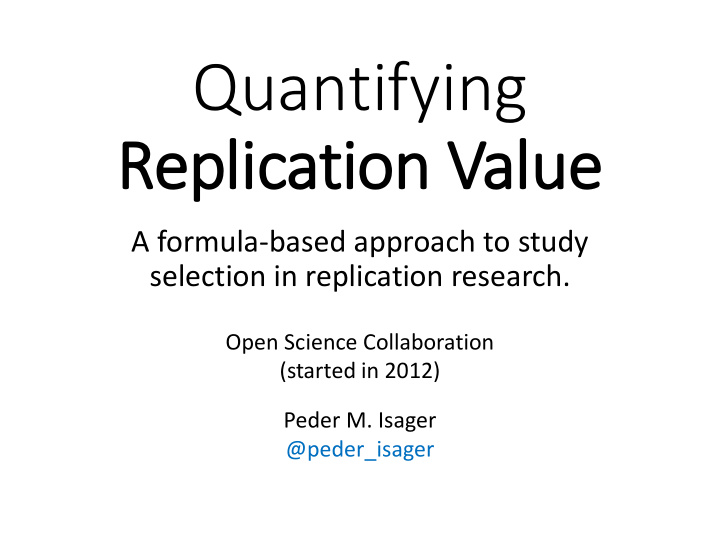



Quantifying Repl plication on V Val alue ue A formula-based approach to study selection in replication research. Open Science Collaboration (started in 2012) Peder M. Isager @peder_isager
New challenges in replication research The amount of non-replicated original research in psychology is vast. We can’t replicate everything (at once). Everything is not worth replicating. What makes a finding worth the resources required to replicate it?
What to replicate? Literature review: https://bit.ly/2JGTbCw • Theoretical impact • Academic impact • Societal impact • Methodological concerns Manual inspection can be time-consuming. How do we search the record efficiently?
Replication value formula: Goals • Provide rough initial estimate of “true” replication value based on quantitative, easily accessible information. • Allow researchers to evaluate larger sets of findings. • Increase the chance that we manually inspect findings that would be particularly fruitful to replicate.
Study selection procedure 1. Determine sample set of findings based on interest and expertise. 2. Use a formula to gain a first quantitative estimate the replication value of the findings. 3. Take a subset of findings with the highest formula replication value – manually evaluate subset. 4. Select the finding in subset most suitable for replication. If no finding in the subset is suitable, repeat step 3 and 4 for a new subset.
Replication value formula: Conceptual definition Impact RV= Corroboration
Replication value formula: Operationalization Example operationalization: RV= Yearly citation rate Sample size Many other possible operationalizations • E.g. default Bayes factor: Field et. al. (2019)
Replication value formula: (some) limitations • The formula is no substitute for detailed subjective evaluation. • Some findings have high formula replication value but are not worth replicating. • Some findings have low formula replication value but are worth replicating. • Sometimes, replication is not the solution.
How to validate?
Avenues for validation • Predictive validity for cases where “true” replication value is known. • Face validity in actual replication efforts. • Predictive validity for researchers’ subjective judgements.
Example: Stroop (1935) Original • Highly cited but also highly corroborated. • “True” replication value is considered low • Updating the formula Total
Planned validation studies Replication project: Targeting studies for replication in social neuroscience. • “Put your money where your mouth is” approach. • 1000 candidates to be evaluated by formula. • Final dataset will be made openly available to other researchers in the field. Empirical project : Can formula replication value predict researchers’ evaluations?
What makes a study worth replicating? www.men enti.com om Code: 77 49 99 77 49 99
Formula rank order Rank Study Crossref citations Sample size Gaillot, Baumeister et al. (2007): 1 st 532 61 ego depletion effect Bargh et al. (1996): 2 nd 1508 30 elderly priming Tversky & Kahneman (1981): 3 rd 6067 307 gain versus loss framing Carney, Cuddy & Yap (2010): 4 th 313 42 power posing effect Bem (2011) : 5 th 215 50 pre-cognition Bressan & Stranieri (2008): 6 th 17 208 Ovulation boosts attraction to single men
Formula behavior RV
Curate Science RV • 166 original findings that have been replicated. • More “famous” efforts get higher RV.
STEP 1: STEP 2: Determine sample set Use a formula to gain a of findings based on first quantitative interest and expertise. estimate the replication value of the findings. STEP 4: STEP 3: Select the finding in Take a subset of subset most suitable findings with the for replication. If no highest formula finding in the subset is replication value – suitable, repeat step 3 manually evaluate and 4 for a new subset. subset.
Recommend
More recommend